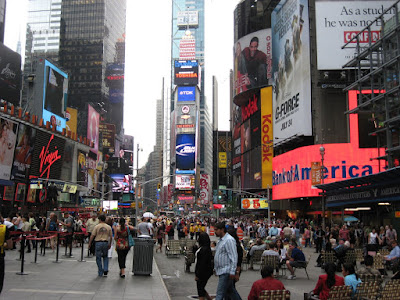“As we rode in the bus in the weird phosphorescent void of the Lincoln Tunnel we leaned on each other with fingers waving and yelled and talked excitedly, and I was beginning to get the bug like Dean” (4).
“Dean, ragged in a motheaten overcoat he brought specially for the freezing temperatures of the East, walked off alone, and the last I saw of him he rounded the corner of Seventh Avenue, eyes on the street ahead, and bent to it again” (292).
“Dean stood outside the windows with his bag, ready to go to Penn Station and on across the land” (292).

“Whenever spring comes to New York I can’t stand the suggestions of the land that come blowing over the river from New Jersey and I’ve got to go. So I went. For the first time in our lives I said good-by to Dean in New York and left him there. He worked in a parking lot on Madison and 40th” (237).
(No parking lots these days)


(So it's a 12-hour difference)
“Suddenly I found myself on Times Square. I had traveled eight thousand miles around the American continent and I was back on Times Square; right in the middle of a rush hour, too, seeing with my innocent road-eyes the absolute madness and fantastic hoorair of New York with its millions and millions hustling forever for a buck among themselves, the mad dream—grabbing, taking, giving, sighing, dying, just so they could be buried in those awful cemeteries beyond Long Island City” (98).




“St. Patrick’s Cathedral: most striking of the windows and I didn’t expect strikingness at this late hour—is at upper front left—a lonely icy congealed blue with streaks of hot pink—little blue holes—painted with an immeasurable blue ink, noir comme bleu, black like blue, I was going to say three Apostles bur there are only two, third slot is not figure, is three one-third-size endisced figures almost like holes in skating ice—but with a winter swamp water full of mill dyes and midnight—no sky has had the color of this glass, and I know skies—all other windows here now dimming except this—it faces East, must be amazing tomorrow morning—faces East like my poor hospital window—Lord, I scribbled hymns to you—the other windows grow rich, brown, dark, secret, get better with age of light like wine with age of Time—the halo round the head of first figure remains bright and shining in the now general midnight blue of the window—halo of second figure is more humble—this window is secreted away and almost has same color as windows at halfway point turningpoint of stairs in old Victorian homes—concealed too—Only now I begin to notice the green—The similar triple window behind and above altar is now gone into the night—but not here.” (Visions of Cody 28).
The hints at the window mentioned in Visions of Cody were a lot more difficult to decipher once I was actually in the Cathedral. I'm not absolutely certain, but after I scrutinized every pane of stained glass in the place I believe the above window is Kerouac's window.
“Since the Dakar Doldrums he [Carlo] had gone through a terrible period which he called the Holy Doldrums, or Harlem Doldrums, when he lived in Harlem in mid-summer and at night woke up in his lonely room and heard ‘the great machine’ descending from the sky; and when he walked on 125th Street ‘under water’ with all the other fish. It was a riot of radiant ideas that had come to enlighten his brain” (On the Road 121).
“I took the Seventh Avenue subway to the end of the line at 242nd Street, and there took a trolley into Yonkers; in downtown Yonkers I transferred to an outgoing trolley and went to the city limits on the east bank of the Hudson River. If you drop a rose in the Hudson River at its mysterious source in the Adirondacks, think of all the places it journeys by as it goes out to sea forever—think of that wonderful Hudson Valley” (9).

















No comments:
Post a Comment